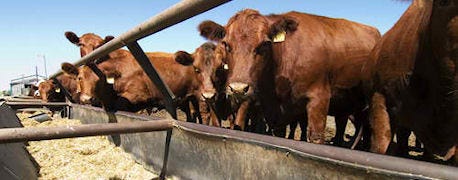
The three key numbers in Friday's USDA report all came in on the friendly side of trade guesses. The differences are small. Still, the report should provide a bit a lift to cattle complex futures Monday.
Cattle and calves on feed for slaughter market in the United States for feedlots with capacity of 1,000 or more head totaled 10.725 million on Dec. 1, 2013. The inventory was 5% below Dec. 1, 2012. This is the second lowest inventory for December 1 since the series began in 1996. USDA's number is 10,000 head below the average of analysts surveyed by Dow Jones before the report.

On-feed inventory down 5% points to further tightening of supplies into 2014.
Placements in feedlots during November totaled 1.882 million, 3% below 2012. Net placements were 1.81 million head. On average traders expected November placements to be about 1.960 million or 78,000 more than USDA's estimate. That's friendly.
November placements of cattle and calves weighing:
Less than 600 pounds were 585,000
600 to 699 pounds were 510,000
700 to 799 pounds were 362,000
800 pounds and greater were 425,000.
Marketings of fed cattle during November totaled 1.681 million, 5% below 2012, but 15,000 higher than traders expected.
December was the sixteenth straight month of lower feedlot inventories on a year-on-year basis. It was also the lowest Dec. 1 feedlot inventory since 1996. Fed cattle slaughter could easily be 4.5% to more than 6% below year-ago levels over the next five to six months.
Ranchers choose to hang onto feeders. Placements are always trickier to predict than the on-feed inventory or marketings. Feed costs are much more favorable than a year ago, encouraging cattle feeders to fill feedlots.
However, pasture conditions in much of the country are also much better than a year ago. Cattle price prospects also appear solid well into the future. Those forces encourage cow-calf producers to put on more gain on grass before they sell feedlot replacements to feed yards. They also encourage cow-calf operators to hang onto heifers to expand cow herds.
The lower placements than traders expected suggest more cattle are staying on ranches a bit longer which will delay placements and further tighten intermediate term fed cattle supplies. The larger than expected marketings further tighten near term supply. Cattle that are already in the beef cooler or on dinner plates cannot come to market later.

Consumers to eat less beef, pay more for it. USDA projects the 2014 annual average five-area direct choice steer price will average in the $128 to $137. That's up from this year's roughly $125.80 average.
Consumers will be paying higher retail prices for beef and they'll eat less of it. Some casual market observers will call that a decline in demand. That's not automatically so. It may well simply be a shift in quantity demanded to a higher price, lower quantity point on an existing demand curve.
That concept provides solace to beef producers who worry about demand erosion. It provides little solace to consumers who will make harder choices about where to spend their meat protein dollars.
To give you a feel for the trend, USDA estimated the annual average all fresh beef retail value for 2011 at $4.44 a pound. It advanced to $4.69 in 2012. It's tracking toward $4.96 this year. It will be higher in 2014.
About the Author(s)
You May Also Like




